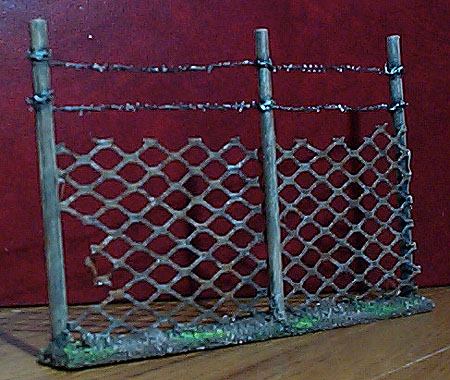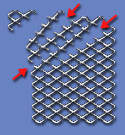 |
|
Fences like these can be used in almost any game from 20th century historical periods to Warhammer 40,000 and cyberpunk settings. They make an interesting terrain feature because they block movement yet provide no cover.
At smaller scales net curtain material could be used, but at this size it would be a bit floppy, as the stiffness of the mesh helps support the fence posts. |
Materials
|
|
|
Barbed Wire
|
Cutting the Mesh
Reinforcing the Wire Now separate off a single strand of fuse wire (about 50% longer than the lehgth you want the finished strand of barbed wire to be), and twist it together with the strip of mesh.As you do this, make sure the strip of mesh itself is being twisted, so that the 'barbs' stick out in all direction, rather than all being lined up. Each time you get to a joint in the mesh-wire, wrap the fuse wire in a tight coil round this point to reinforce it as these are particular weak points.
|
Main Fence
|
|
Attach mesh to base If your mesh is very solid, as it was in this example, you may find it easiest to stick this on first and then stick the posts to the mesh. I used a glue gun for this, and once the mesh was stuck to the board, I ran along both sides of it again with the glue gun to get a really strong joint. Attach posts To attach the barbed wire, it is best to actually wrap it around the skewers and then add a drop of superglue or PVA. Apply texture to base |
Painting
|
|
Mesh & Barbed Wire Posts |

